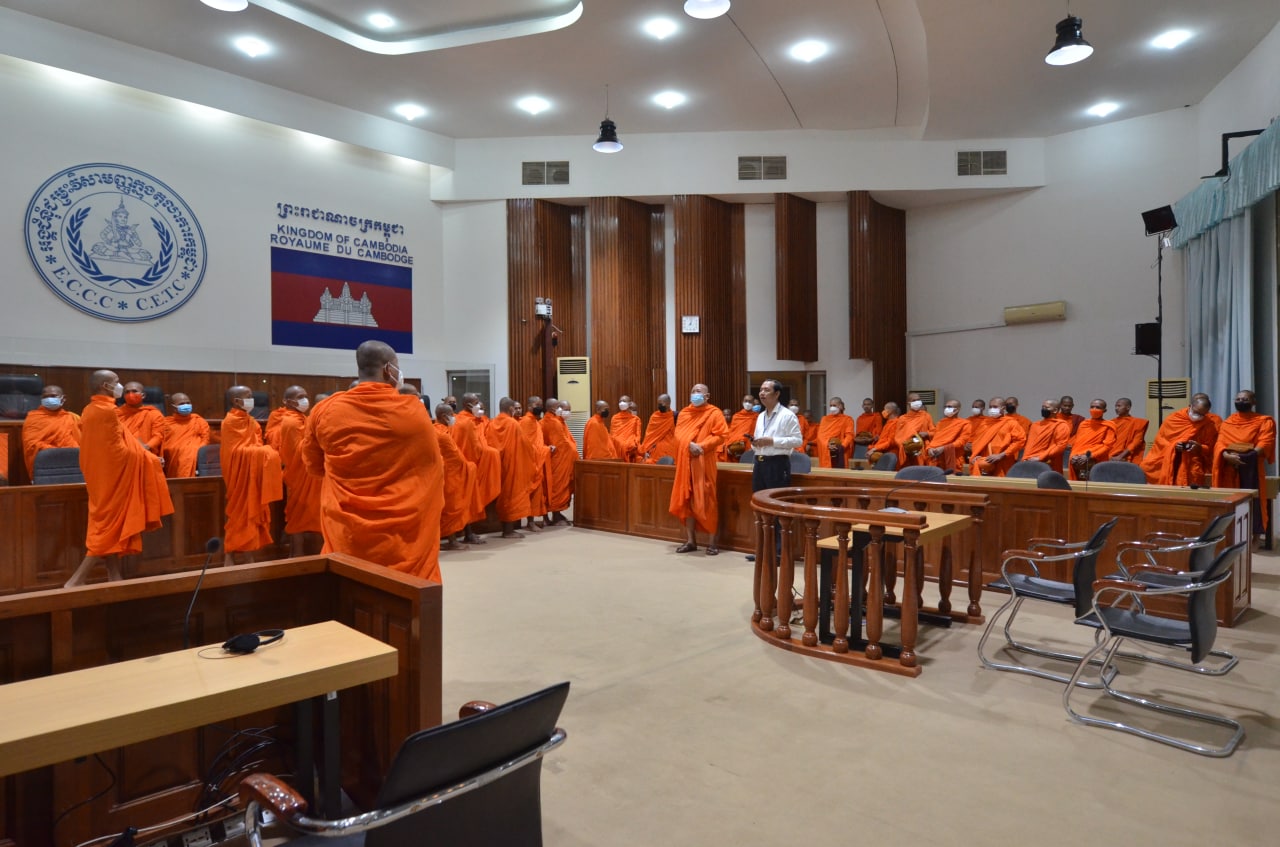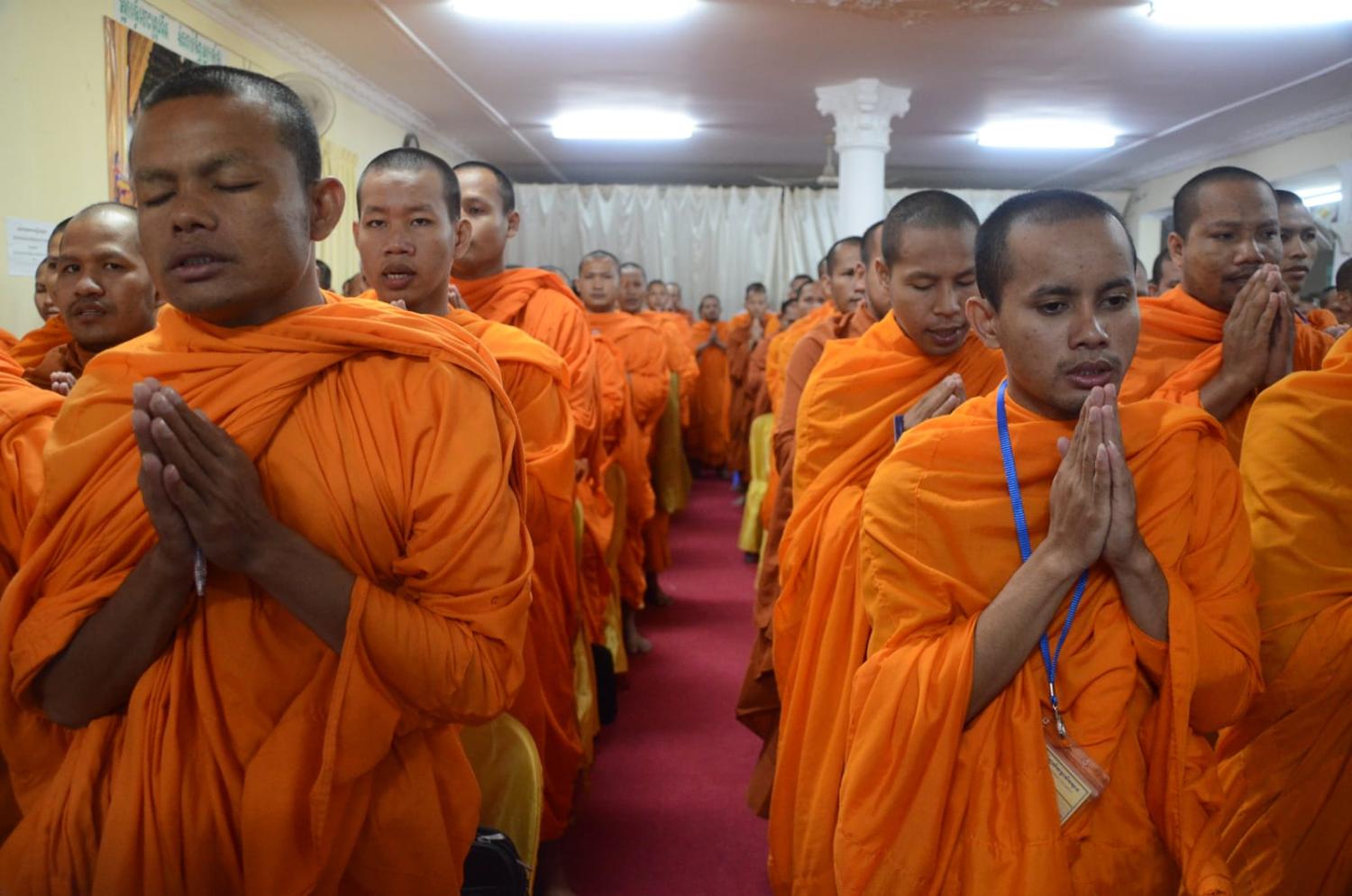At the courtroom premises, robed monks gathered to chant. Candlelight cast a gentle glow as tendrils of incense wafted through the air, creating a sacred atmosphere as sunlight painted the ornate walls. It’s not the type of scene that typically springs to mind of a court, not least one involving hearings of heinous crimes against humanity. But at the end of trial proceedings, this Buddhist ritual commemorated victims who perished under the Khmer Rouge, blending the essence of spirituality and justice.
The Extraordinary Chambers in the Courts of Cambodia (ECCC) was created in response to the atrocities committed by the Khmer Rouge regime. Over a span of 16 years, with hearings concluding in 2022, the ECCC oversaw a series of significant “firsts”. One was embracing Buddhist-informed healing practices, by joining meditation and spirituality with international criminal law’s reckoning of mass atrocity crimes – marking a legacy as Asia’s first post-war international tribunal.
The Khmer Rouge regime orchestrated two million Cambodian deaths in pursuit of an agrarian and homogeneous society. The events from the late 1970s involved systematic persecution and forced labour of various groups. And in this time, the Buddhist-majority nation saw the execution of monks, forced marriages, and widespread destruction of cultural heritage, rupturing Cambodia’s collective consciousness.
After the fall of the Khmer Rouge in 1979, many survivors turned to Buddhist institutions for guidance in confronting the deep psychological wounds left by mass violence. Aligned with Theravada teachings, monks re-introduced Karma, encouraging victims to consider their previous actions, cycle of suffering, and eventual reckoning. Buddhist monks also led Samadhi and Vipassana – meditation practices promoting mindfulness, inner peace and self-awareness. Recognising Buddhism’s complexity and Cambodia’s multi-faith population, the widespread resonance of these general principles among victim populations positions Buddhist institutions as key stakeholders in the country’s post-genocide recovery.

One distinct feature of the ECCC was the Trial Chamber’s issuance of collective and moral reparations, including testimonial therapy. Testimonial therapy constitutes a form of individual psychotherapy designed for survivors by truth-telling and reciting traumatic encounters. In the ECCC, testimonial therapy often consists of a symbolic purification ritual and a form of spiritual release, allowing victims to recover their dignity.
In Takeo Province, the ECCC partnered with local Buddhist groups to facilitate this therapy. Guided by a therapist, participants’ traumatic experiences are acknowledged, culminating in a formal testimony delivered during a ritual and presented to a monk. The monk’s blessing profoundly empowered the participant, “giving back” the narrative to victims. Victims found this session helpful in managing post-traumatic stress disorder and later were integrated with clinical psychotherapy.
Testimony therapy was even employed with victims of the notorious “Killing Fields”, where survivors revisited their Khmer Rouge memories amid mass graves. The ceremony began with a Stupa ritual. Kneeling before monks, participants prayed, burned incense, received blessings, and listened to testimonies. Following the emotional experience at the Killing Fields, a sense of tranquillity embraced the pagoda. Survivors prayed before a Buddha statue, and counsellors summarised testimonies before reading them. Monks purified documents, tied threads, and blessed survivors. The ceremony concluded with monks’ blessings and the sprinkling of holy water, implanting a sense of purification.
Simultaneously, the tribunal facilitated Dhammayietra, a form of monk-led walking meditation, wherein survivors walk together to sacred sites and find solace in shared trauma while chanting in the sacred languages of Pali and Sanskrit alongside Khmer. The concept of addressing the past through testimonial therapy is shown by the Ksem Ksan Association, a Buddhist civil society group. At S-21, a former torture chamber, Chum Mey, a Buddhist Monk and one of the few survivors of the facility, stated:
We held a Buddhist ceremony in S-21, and the idea of having a ceremony there was to dedicate to those who died in S-21. We would like the dead people to know that we are going to seek justice for them.
The ECCC is likely the first international court to direct such practices as legitimate remedies under international law, representing an attempt to not only to hold individuals criminally responsible but also to restore the dignity of victims. While only a few civil parties were awarded testimonial therapy, they were well received, highlighting the value of further use in future healing processes with affected communities in post-conflict societies.
Beyond the reparation’s legal framework, the ECCC led outreach projects with Buddhist monasteries and community organisations. The tribunal’s Deputy Director Knut Rosandhaug addressed a congregation of 400 monks, noting that “being respected monks, through this special and privileged standing in this society, can complement the court proceedings by assisting victims and perpetrators to reconcile”.
Similarly, the tribunal supported visits from Buddhist congregations from Japan, Thailand and Myanmar with their Cambodian counterparts, collectively praying for cultural rejuvenation and universal peace. During breaks in trials, Buddhist congregations organised ornate blessing ceremonies in the courtroom. They erected a large statue of a revered spirit in Cambodian Buddhism, offering a comforting space for victims to take an oath before facing the accused.
Now in its residual phase, mandating functions such as ongoing enforcement of reparations and “information dissemination”, the ECCC has a unique opportunity to positively disrupt the over-representation of Eurocentric trends in international law. The experience with the ECCC blurs the conventional role of the international tribunal by leading victim-centred projects, extending beyond solely zero-sum criminal litigation. Termed a “networked mechanism”, it explores the potential of localised justice through Buddhist-inspired approaches, opening discussions about the tribunal’s unique status being physically located at the crime site, along with the often overlooked role of religion in community healing.
The court stands as an experiment in transitional justice, highlighted by convicting Khieu Samphan, history’s first head of state for genocide. Despite obstacles such as allegations of political interference, limited personal jurisdiction and financial burdens, the ECCC’s approach shows how faith-based interventions and criminal prosecutions can innovatively meet, fostering healing in the aftermath of mass atrocities.
The opinions expressed in this article are those of the author and do not reflect the views or positions of any institutions they represent.

